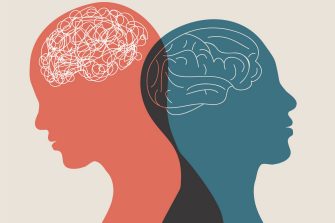New research suggests mental wellbeing should be measured alongside standard tests for mental health conditions.
Measuring wellbeing alongside measures of psychological distress will paint a more accurate and thorough picture of mental health, say scientists at UNSW Sydney, opens in a new window and Neuroscience Research Australia (NeuRA), opens in a new window.
In a new study, published today in Frontiers in Psychiatry, opens in a new window, scientists have developed and validated an effective measure for mental wellbeing among adolescents, a factor that has traditionally been left out of mental health research.
The latest results found that adolescents who have clinical symptoms of mental ill-health or neurodevelopmental conditions, for example those who have been diagnosed with anxiety or depression, or ADHD, don’t necessarily score low on mental wellbeing. Likewise, those who are not clinically diagnosed with these conditions don’t necessarily score highly for mental wellbeing.
“If you consider the full definition of what mental health is, it's not just about the illness symptoms, it's also about mental wellbeing, and they're not simply opposite ends of a single spectrum,” says Associate Professor Justine Gatt, who holds a joint position at UNSW Psychology, opens in a new window and NeuRA, and led this project.
The research team hopes this study helps to challenge some of the misconceptions around wellbeing and mental ill-health, and encourages a more holistic approach to mental health research.
“The gold standard treatment for anxiety or depression could be supplemented with wellbeing programs that focus on positive emotions, self-worth, and autonomy,” says A/Prof. Gatt. “If well managed, people with chronic mental health or neurodevelopmental conditions can report higher levels of wellbeing so that they are more functioning and content.”
Media enquiries
For enquiries about this story and to arrange interviews please contact Lilly Matson.
Tel: 0426 656 007, opens in a new window
Email: l.matson@unsw.edu.au, opens in a new window

How can you accurately measure wellbeing?
Measuring wellbeing has historically been “messy”, A/Prof. Gatt says. There is a common misconception that mental health is defined solely by diagnosable symptoms, and if you have an absence of symptoms, then you are doing well.
“In research, if mental wellbeing is measured as part of mental health, it typically includes measures of life satisfaction alone, and not mental wellbeing in its entirety,” says A/Prof. Gatt. “This has left us with an incomplete understanding of what is going on.”
In 2014, A/Prof. Gatt and her team developed the COMPAS-W scale, a measurement scale that has already been validated in adults. Unlike many previous measurements of wellbeing, this scale incorporates the two key elements of mental wellbeing – known as hedonia and eudaimonia.
“Hedonia, which is sometimes called subjective wellbeing, is your life satisfaction, but also happiness, pleasure and enjoyment,” says A/Prof. Gatt. “And the other key component is eudaimonia, which is also sometimes called psychological wellbeing, which is made up of factors such as whether someone has a sense of life purpose, mastery, autonomy and self-worth.”
The COMPAS-W scale takes a couple of minutes to complete and is made up of 26 questions, with ratings on a scale of one to five that cover elements of hedonia and eudaimonia. “By completing the scale, you will get a total score for your wellbeing, and from there we are able to categorise results into whether someone’s mental wellbeing is languishing, moderate or flourishing,” says A/Prof. Gatt.
“But there are also six sub-scales to COMPAS-W which include composure, own-worth, mastery, positivity, achievement and satisfaction.”
The COMPAS-W scale
The data used in this study was collected in 2020 as part of a grant from Instagram to understand the impact of social media on wellbeing. The cohort had been asked to complete the COMPAS-W scale, as well as a series of other surveys. “So, for this particular paper, we pulled the data from respondents aged between 13-17 years old,” says A/Prof. Gatt.
The team analysed the responses of 1078 adolescents across Australia and the US.
“The psychometric tests found that the COMPAS-W structure did hold for this age group,” says A/Prof. Gatt. “We also found that the scale was more reliable in this age group when we removed a few items, so it ended up reducing the total scale from 26 to 23 questions.”
Importantly, the cohort was taken from a general population sample. “This means that this group naturally included a sample of what you would see in the general population – about 20 per cent had a mental health condition, or developmental disorder,” says A/Prof. Gatt.
“So we wanted to actually look at how wellbeing differs in those who have a diagnosed mental health condition and/or neurodevelopmental disorder, compared to those who don’t.”
Digging into the results
The results found that on average, individuals who had a clinical mental illness diagnosis or neurodevelopmental disorder had lower wellbeing than non-clinical groups.
However, when looking at classification of wellbeing by the categories – languishing, moderate and flourishing – both clinical and non-clinical groups demonstrated incidence of wellbeing across all three categories.
For example, over half of the participants diagnosed with either a mental health condition or neurodevelopmental disorder scored moderate for wellbeing – 65 per cent and 71 percent respectively – and a small group fell into the flourishing category (1.5 per cent and 5.6 per cent respectively).
This means the clinical groups were mostly “moderately well” despite their diagnosis. The exception to this was for those with both psychiatric and neurodevelopmental conditions, for which incidence for moderate wellbeing was lower, at 46 per cent. On the other side of the coin, there were many participants without a clinical diagnosis who nonetheless fell into the languishing category, or who had moderate mental wellbeing.
“This is a really significant finding because in many people, these conditions are chronic or recurring,” says A/Prof. Gatt. “For some people, ADHD or chronic anxiety symptoms, for example, can persist into adulthood, and are conditions they have to learn to live with. So, to show that someone can still achieve adequate wellbeing is an important finding to share.”
A call for change
As expected, the average scores for the clinical groups overall have a lower wellbeing than the ‘healthy’ groups, but digging into the results emphasises that the presence of illness does not mean an absence of wellbeing.
The team believe there are several reasons for these results. It is possible that individuals with clinical conditions who report moderate and, in a few cases, high wellbeing, have their condition well managed with pharmacological or behavioural treatment.
“If someone is managing their symptoms with treatment, you can imagine they may have the capacity to build their wellbeing. Someone may have the energy or the motivation to do things that they enjoy, which promotes positive emotions and life satisfaction and perceived control,” says A/Prof. Gatt.
Similarly, it is plausible that non-clinical individuals report languishing wellbeing despite the absence of diagnosed clinical symptoms. In these cases, there is likely one of two scenarios happening. Either the participants did not seek medical support for feelings of low wellbeing (for whatever reason), or they did seek medical support but their symptoms were not deemed severe enough to be referred on to specialist mental health care.
Based on these findings, the research team are calling for the inclusion of measures of wellbeing alongside psychological distress to enable a better understanding of needs for early intervention in those who may not meet criteria for psychiatric illness, but are scoring low in wellbeing.
The inclusion of both measures also has the potential to help personalise treatment options in those who meet criteria for diagnosed illness and have low scores in wellbeing.
"We’re currently working on validating a COMPAS-W scale for children, aged five to twelve. In future work, we want to study how wellbeing changes over the lifespan,” says A/Prof. Gatt. “But in the meantime, we’d like to increase awareness in the general public, but also researchers and clinicians on what this looks like, and eventually we’d like to see how mental health strategies can incorporate a measurement and promotion of wellbeing in those who need it.”
Related stories
-

Nature vs nurture: shedding light on heritable brain activity
-

More than just 'staying strong': what tough times can teach us about resilience
-

What’s the difference between shyness and social anxiety?
-

Australia is getting a new digital mental health service. Will it help? Here’s what the evidence says





